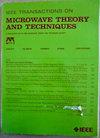A Ka-Band Four-Beam High-Linearity Transmitter With Beam Interference Cancellation for SATCOM Multibeam Communication
IF 4.1
1区 工程技术
Q2 ENGINEERING, ELECTRICAL & ELECTRONIC
IEEE Transactions on Microwave Theory and Techniques
Pub Date : 2025-02-27
DOI:10.1109/TMTT.2025.3542097
引用次数: 0
Abstract
This article presents a 27.7–31.2-GHz highly integrated eight-element, four-beam transmitter front end in 65-nm CMOS for phased-array multibeam communication. To eliminate beam interference in multibeam coherent communication, an interference cancellation scheme is introduced within the multibeam transmitter. In the circuit design, the proposed hybrid variable-gain amplifiers (VGAs) combine digital common-source (CS) VGAs and analog Gilbert-cell-based VGAs to achieve both a large dynamic range and high resolution. The hybrid VGAs are then embedded into a transmission-line-based network, forming a compact用于卫星通信多波束通信的ka波段四波束高线性波束干扰消除发射机
本文提出了一种用于相控阵多波束通信的65纳米CMOS高集成度的27.7 - 31.2 ghz八元四波束发射器前端。为了消除多波束相干通信中的波束干扰,在多波束发射机内部引入了一种干扰消除方案。在电路设计中,所提出的混合可变增益放大器(VGAs)结合了数字共源(CS) VGAs和基于吉尔伯特单元的模拟VGAs,以实现大动态范围和高分辨率。然后将混合VGAs嵌入到基于传输线的网络中,形成紧凑的$4\ × 4$波束组合结构。为了支持多波束相位控制,四对Gm阵列从低通和高通集总延迟线产生的相同I/Q信号中插入四个单独的相位状态。这些延迟线插入在CS晶体管和共栅极(CG)晶体管之间,以隔离磁耦合谐振负载跨频率的阻抗波动。为了控制高峰值平均功率比(PAPR)调制信号,输出级采用了对称变压器型Doherty负载调制网络,并在辅助路径中采用模拟自适应增益控制来提高功率回切(PBO)效率。在1.1 v电源电压下,该发射机的饱和输出功率(Psat)为19.2 dBm,信道效率(CE)为20.5%,输出功率1-dB压缩点(OP1dB)为18.2 dBm。测量的最大漏极效率(DE)为40.8%,而6 db PBO DE为28%,与标准化的b /A类实现相比,提高了40%/180%。所提出的混合VGA实现了27 db的调谐范围和0.25 db的增益步长,增益/相位误差为0.26 db /1.9°均方根(rms),而相移器(PS)实现了6位,360°相移,增益/相位误差为0.25 db /2.5°rms,实现了精确的增益锥形和波束转向。
本文章由计算机程序翻译,如有差异,请以英文原文为准。
求助全文
约1分钟内获得全文
求助全文
来源期刊

IEEE Transactions on Microwave Theory and Techniques
工程技术-工程:电子与电气
CiteScore
8.60
自引率
18.60%
发文量
486
审稿时长
6 months
期刊介绍:
The IEEE Transactions on Microwave Theory and Techniques focuses on that part of engineering and theory associated with microwave/millimeter-wave components, devices, circuits, and systems involving the generation, modulation, demodulation, control, transmission, and detection of microwave signals. This includes scientific, technical, and industrial, activities. Microwave theory and techniques relates to electromagnetic waves usually in the frequency region between a few MHz and a THz; other spectral regions and wave types are included within the scope of the Society whenever basic microwave theory and techniques can yield useful results. Generally, this occurs in the theory of wave propagation in structures with dimensions comparable to a wavelength, and in the related techniques for analysis and design.
 求助内容:
求助内容: 应助结果提醒方式:
应助结果提醒方式:


